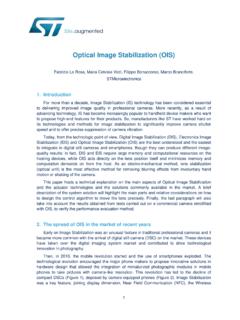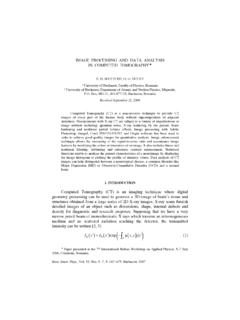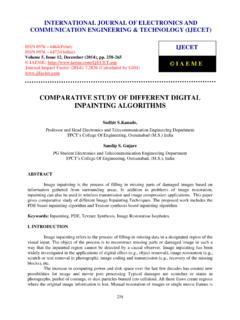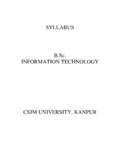Transcription of Prism-Based Color Separation for Professional …
1 Reprint --- PICS 2000, March 28, PortlandPrism-Based Color Separation for ProfessionalDigital PhotographyRichard F. LyonFoveon, Clara, CA USAA bstractIn the field of silver-halide photography , colorseparation was explored about a century ago, using filtermosaics, dichroic mirrors, three-shot filtration, and othertechniques, before the dominant technology of multi-layeredcolor film emerged. In the field of digital photography , thesame techniques are being explored now in conjuction withsilicon sensor technology. The three-shot technique, and therelated tri-linear scanning technique, can deliver excellentimages, but are awkward to employ and unsuitable forsubjects that move.
2 The filter-mosaic aproach is currentlydominant in the digital camera market, but its inevitablealiasing artifacts limit its applicability in the Professional endof the business. The use of dichroic mirrors, embedded inprisms as in Color -TV cameras, has been attempted by a fewcamera vendors, so far with limited success. The demand forbetter digital images, however, has provided a continuingincentive to work on making this three-sensor approachfeasible. Several key problems must be solved to make aviable Professional camera using this approach: first, sensorswith high enough resolution and image quality must be madeat a cost that allows three of them to be included in aproduct; second, a prism must be designed for good colorreproduction fidelity and must be economically and preciselymanufactured; third, the three sensors must be opticallyaligned to the prism in a way that avoids ghost reflectionsand other problems.
3 And finally, a whole new camera systemneeds to be designed around such a three-channel sensorassembly. This paper recounts some of the ways in whichthese problems are addressed in the design of the recentlyintroduced Foveon Studio Camera, and provides qualitativeassessments of the resulting advantages in image quality Prism-Based , three-sensor, one-shot electronic studiocamera and system recently introduced by Foveon cameabout as a result of understanding the history of approachesto Color photography , and through an analysis of theopportunities to improve the quality of electronic away from the mainstream of CCD sensors withcolor filter mosaics presented a number of technicalchallenges, but has paid off in terms of image quality,especially in delivering an essentially artifact-free PerspectiveThe exploration of Color Separation approaches forelectronic photography parallels in many respects theexplorations that were done for silver halide photographyaround the previous turn of the century.
4 But the outcome, interms of a dominant high-quality technology, is likely to bequite different. Three-shot approaches have enjoyed limitedsuccess in both histories, but for general usage, one-shotapproaches are required. As Friedman [1] noted in 1944:To photograph an object in Color , an operator has at hiscommand a variety of methods. He can use a one-shotcamera in which the lens beam is divided into three partsby any one of the many mechanisms canuse one of the integral processes, such as Kodachrome,Ansco Color , Dufaycolor, photograph the subject through three filters in cases where the object remainsperfectly are called repeating we see the concepts of camera back distinct fromcolor camera, and three-shot versus one-shot, but to see howthe filter-mosaic approach fits in, we need to read further.
5 Because that approach had already slipped out of use at thatwriting:The integral methods for the preparation of colorphotographs are not confined to the monopacks. Ducosdu Hauron suggested a much simpler method almost fiftyyears before the monopack was even alternating lines of red, blue, and goes on to note the problems with the screen-plate patterns, the inefficiencies due to the fact that theindividual screen elements transmit but a fraction of all thelight falling on them, and the severe blow dealt to thisapproach at the introduction of Kodachrome, Ansco Color ,and Agfacolor.
6 In the era of silicon sensors andmicrolithography, the ability to pattern fine-scale filtermosaics has given this approach a resurgence. It is now thedominant approach to electronic Color photography in spiteof its problems of inefficient use of light and a tendency toproduce Moir patterns and other artifacts (errors knowncollectively as aliasing, due to the spatial sampling of thecolors being too sparse relative to spatial frequencies in theoptical image).In the digital domain, the screen-plate pattern is realizedas a Color filter mosaic aligned to individual pixel sensorelements, so that each location senses only one of the threeprimary colors through its appointed filter.
7 The other twothirds of the Color data at each pixel are then interpolated, orguessed, by various schemes that try to use image statisticsto make up for the fact that all three Color planes are under-sampled, in violation of the Nyquist sampling was against this backdrop that we realized that theimage quality of modern digital cameras is limited byaliasing, not by the number of pixels; using more pixels in afilter mosaic merely pushes the problem to somewhat higherfrequencies. We saw that by using three sensor chips on aprism, a given number of individual pixel-sensor elementscould be used to produce alias-free images, and that all thelight entering the camera could be efficiently , we realized that since high-end imagesensors are always pushing the state of the art of chipfabrication, they are invariably on the steep part of the chipyield-versus-size or cost-versus-size curve; in this regime, itis much more economical to get more pixels from a set ofthree imager chips than from a single larger chip.
8 Thesequality and economy advantages are simultaneously availableby using three sensor chips behind a Color -separating SensorsOur first major challenge was to come up with silicon sensorarrays that would support high resolution at a reasonablecost (since we need three of them per camera), and wouldenable the functionality of a fully digital camera, including alive viewfinder with focus capability. We found good reasonto expect that the faster learning curve of CMOS chipfabrication, compared to CCD, would continue and wouldapply to imagers as well. And only CMOS could supply theflexible readout logic needed for our desired functions.
9 Sowe set about exploring the space of possible image sensorcircuits and architectures in CMOS and related close cooperation with our semiconductor fabricationpartner, National Semiconductor, we have been able todefine modifications to a modern low-voltageCMOS process that allow low-leakage analog functionality,efficient light sensing, and high-speed digital support andtiming circuitry, all within a single chip type. These sensorchips are fabricated with a proprietary semiconductorprocess using mostly standard processing have developed sensor and readout circuits that getaround the shortcomings of more traditional CMOS imagers,including pixel density, fixed pattern (especially column)noise, and readout speed, while supporting efficient readoutof subwindows of arbitrary size and resolution forviewfinder, focus loupe, and autofocus decided early on to go straight to 2Kx2K sensorchips to make a 12-million-sensor imaging assembly.
10 Thesensor chips use 6-micron square pixels, defining the Foveoncamera s 12-mm square details of our sensors remain trade secret and patentpending until the corrresponding patents DesignThe key novel optical component unique to the Foveoncamera is the Color Separation prism that is designed to givea set of three spectral sensitivity curves that closelyapproximate a set of Color matching functions. There hasbeen a long history of Color Separation prisms in the colortelevision industry, but the demands of professionalphotography are much more stringent in terms of opticalresolution, Color accuracy, and alignment between the [2] describes five strategies for Color sensing andprocessing in Color television, distinguishing the degrees andtechniques of approximating Color matching functions ,sensitivity curves modeling human Color and oftransforming the sensed measurements to an outputcolorspace.







